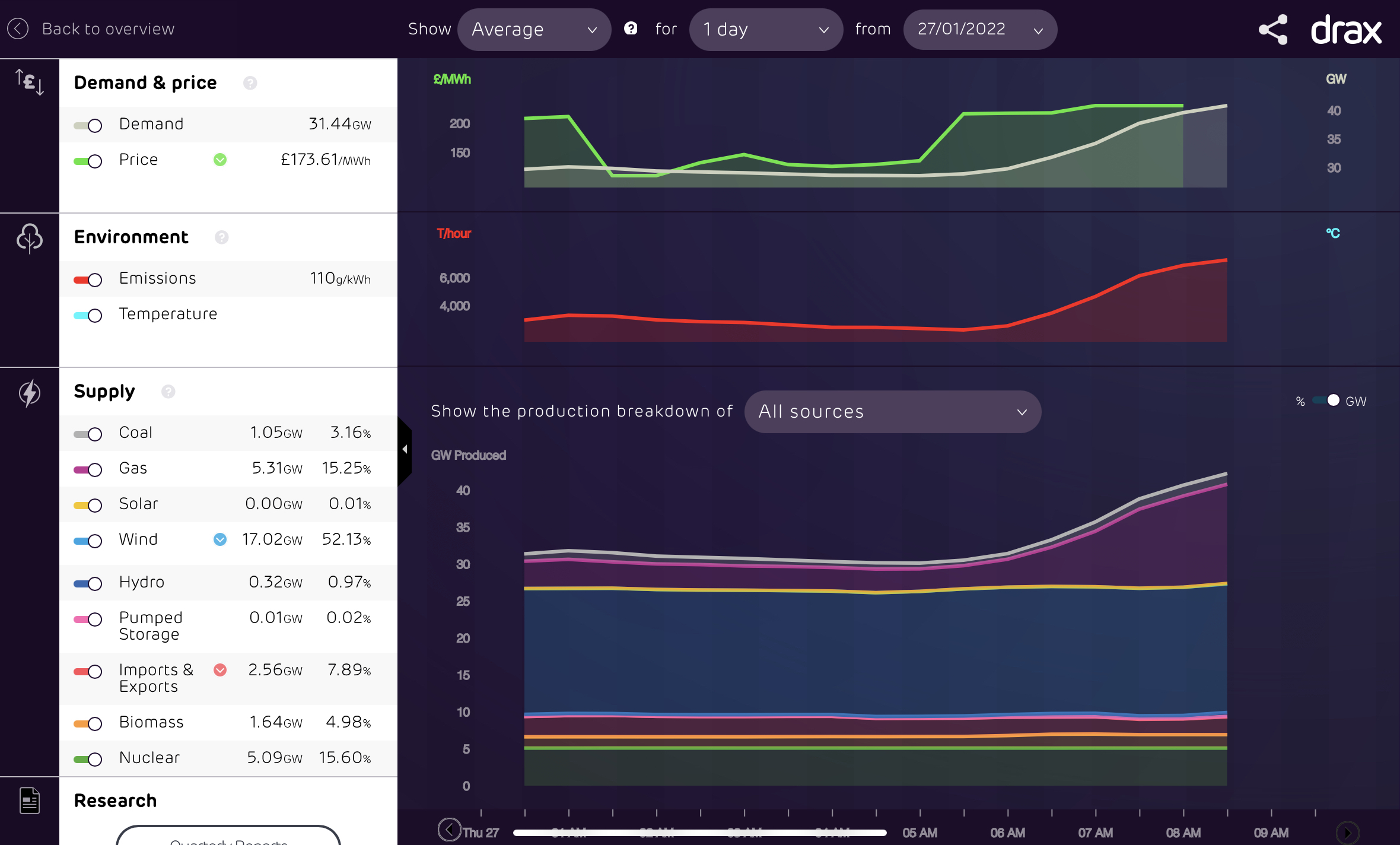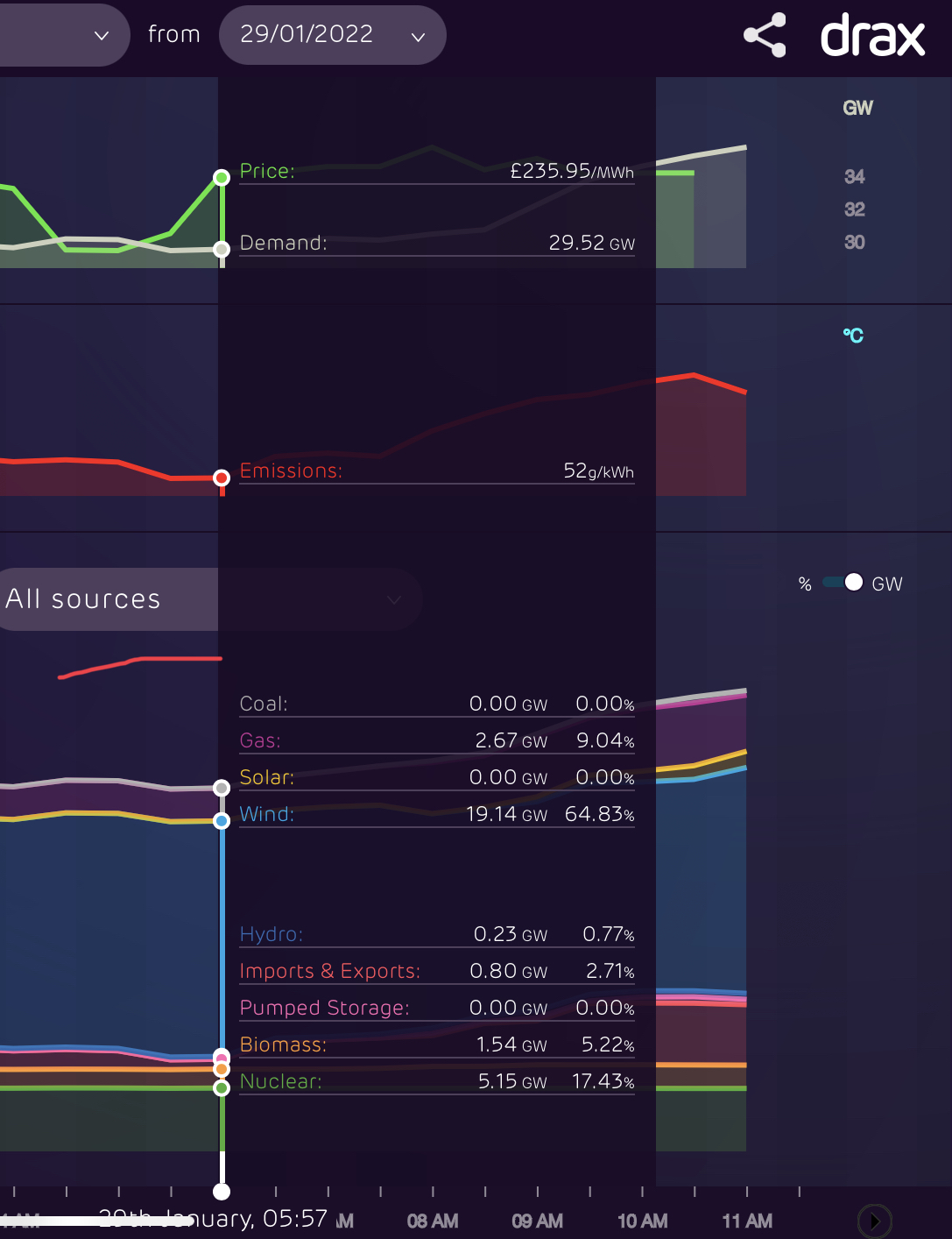We’d like to remind Forumites to please avoid political debate on the Forum.
This is to keep it a safe and useful space for MoneySaving discussions. Threads that are – or become – political in nature may be removed in line with the Forum’s rules. Thank you for your understanding.
📨 Have you signed up to the Forum's new Email Digest yet? Get a selection of trending threads sent straight to your inbox daily, weekly or monthly!
The Alternative Green Energy Thread
Comments
-
If only there were a method of generating electricity which, even if more expensive than other low-carbon methods, could provide a reliable baseline so that we would be less reliant on expensive and polluting fossil fuels to top up unreliable wind and solar.0
-
shinytop said:If only there were a method of generating electricity which, even if more expensive than other low-carbon methods, could provide a reliable baseline so that we would be less reliant on expensive and polluting fossil fuels to top up unreliable wind and solar.
Nuclear?
0 -
Methods abound ! Alas the will to adopt them is lacking.shinytop said:If only there were a method of generating electricity which, even if more expensive than other low-carbon methods, could provide a reliable baseline so that we would be less reliant on expensive and polluting fossil fuels to top up unreliable wind and solar.
As an island nation, we're surrounded by sea which consistently & predictably goes up & down twice a day. We've been talking about building tidal barrages for many years but don't seem to have got beyond talking. Many ports have some form of lock gate which you'd think could be adapted to ensure that water going through them spun a generator.
We have lots of rivers. Not many with spectacular waterfalls but wherever there's a constant flow there should be scope for some sort of submerged impellor.
etc . . .NE Derbyshire.4kWp S Facing 17.5deg slope (dormer roof).24kWh of Pylontech batteries with Lux controller BEV : Hyundai Ioniq51 -
Does an expensive locked in baseline make sense as an addition to cheap but variable RE? Surely that makes high RE penetration uneconomic so basically we would just want to use the expensive baseline power - and then we would also need intraday storage to avoid the non-rampable baseline generator having to run 24/7 which large periods of excess capacity.shinytop said:If only there were a method of generating electricity which, even if more expensive than other low-carbon methods, could provide a reliable baseline so that we would be less reliant on expensive and polluting fossil fuels to top up unreliable wind and solar.
Feels like nuclear and renewables is an either or choice rather than a pick and mix Perhaps if we are going down the RE path we need to go 90% RE and 10% FF with CCS or similar to address the emissions from that 10% - CC is expensive but if current power prices are the new normal then what was too expensive may start to make sense?I think....0 -
It becomes progressively more difficult and expensive to squeeze the last bit of CO2 out of the system so maybe we should ditch this obsession with net Zero on our little patch of the earth and spend the money picking the low hanging fruit around the rest of the world. £400bn would be much better spent in Africa or India on solar and wind projects than on storage in the UK. We would only need it a few days a year. That money could be producing huge savings on CO2 elsewhere. £1000 spent on solar panels in equatorial countries will produce twice the solar PV output we get from spending it in the UK. It would provide consistent year round generation rather than the seasonal peaks and troughs we see in the UK the pattern of which is inverse to demand.Net Zero for the UK is an expensively wasteful vanity project. It benefits us not one jot as a nation if the undeveloped world is still building coal fired generation plants. Spend the money where it will make a real difference.
Edit:£400 bn not £400tn, sorry.Northern Lincolnshire. 7.8 kWp system, (4.2 kw west facing panels , 3.6 kw east facing), Solis inverters, Solar IBoost water heater, Mitsubishi SRK35ZS-S and SRK20ZS-S Wall Mounted Inverter Heat Pumps, ex Nissan Leaf owner)2 -
Just a thought, looking at today’s generation - very steady wind around 17GW - wouldn’t bit be great if we could somehow equip wind and solar generation with some kind of inertia, such as an absolutely massive flywheel that kept on rotating for days on end, sufficient to smooth out the day’s peaks and troughs in demand. It doesn’t have to be at the site of generation although that would reduce the grid transmission costs.

https://electricinsights.co.uk/#/dashboard?start=2022-01-27&&_k=sp9x6w
edit: just done a bit of research and see that this has been considered in the past and adopted on a micro and small scale but considered unsuitable for large installations.Never say never, though.
https://www.sciencedirect.com/topics/engineering/flywheel-energy-storage
Edit 2: this is a small system in operation but nowhere near the scale (and far more sophisticated) than what I was thinking of. https://energydigital.com/smart-energy/worlds-largest-flywheel-energy-storage-systemI had in mind a rotating mass of concrete the size of a large building. (The inspiration for this - when I was a lad we had a grindstone around 4 feet in diameter and 6” thick mounted vertically with a shaft resting in a couple of vertical railway sleepers and powered by winding a handle. It used to take a while to get up to speed then would turn on its own for several minutes.)
A bit like this but ours was about twice the diameter. Northern Lincolnshire. 7.8 kWp system, (4.2 kw west facing panels , 3.6 kw east facing), Solis inverters, Solar IBoost water heater, Mitsubishi SRK35ZS-S and SRK20ZS-S Wall Mounted Inverter Heat Pumps, ex Nissan Leaf owner)1
Northern Lincolnshire. 7.8 kWp system, (4.2 kw west facing panels , 3.6 kw east facing), Solis inverters, Solar IBoost water heater, Mitsubishi SRK35ZS-S and SRK20ZS-S Wall Mounted Inverter Heat Pumps, ex Nissan Leaf owner)1 -
Interesting how high the price remains despite the windJKenH said:Just a thought, looking at today’s generation - very steady wind around 17GW - wouldn’t bit be great if we could somehow equip wind and solar generation with some kind of inertia, such as an absolutely massive flywheel that kept on rotating for days on end, sufficient to smooth out the day’s peaks and troughs in demand. It doesn’t have to be at the site of generation although that would reduce the grid transmission costs.
https://electricinsights.co.uk/#/dashboard?start=2022-01-27&&_k=sp9x6w
edit: just done a bit of research and see that this has been considered in the past and adopted on a micro and small scale but considered unsuitable for large installations.Never say never, though.
https://www.sciencedirect.com/topics/engineering/flywheel-energy-storage
Edit 2: this is a small system in operation but nowhere near the scale (and far more sophisticated) than what I was thinking of. https://energydigital.com/smart-energy/worlds-largest-flywheel-energy-storage-systemI had in mind a rotating mass of concrete the size of a large building. (The inspiration for this - when I was a lad we had a grindstone around 4 feet in diameter and 6” thick mounted vertically with a shaft resting in a couple of vertical railway sleepers and powered by winding a handle. It used to take a while to get up to speed then would turn on its own for several minutes.)
A bit like this but ours was about twice the diameter. I think....0
I think....0 -
Northern Lincolnshire. 7.8 kWp system, (4.2 kw west facing panels , 3.6 kw east facing), Solis inverters, Solar IBoost water heater, Mitsubishi SRK35ZS-S and SRK20ZS-S Wall Mounted Inverter Heat Pumps, ex Nissan Leaf owner)1
-
If we keep those sorts of numbers the "green levy" will be negative again this quarter!
N. Hampshire, he/him. Octopus Intelligent Go elec & Tracker gas / Vodafone BB / iD mobile. Ripple Kirk Hill Coop member.Ofgem cap table, Ofgem cap explainer. Economy 7 cap explainer. Gas vs E7 vs peak elec heating costs, Best kettle!
2.72kWp PV facing SSW installed Jan 2012. 11 x 247w panels, 3.6kw inverter. 34 MWh generated, long-term average 2.6 Os.0 -
The problem with flywheels is that the losses are quite big and go up with scale (air resistance, friction). I saw some research into an energy storage system for a train which used a flywheel held in position using magnets and super-conductors to avoid bearings, operating in a vacuum it was capable of silly speeds and high energy density. Perhaps it was this:michaels said:
Interesting how high the price remains despite the windJKenH said:Just a thought, looking at today’s generation - very steady wind around 17GW - wouldn’t bit be great if we could somehow equip wind and solar generation with some kind of inertia, such as an absolutely massive flywheel that kept on rotating for days on end, sufficient to smooth out the day’s peaks and troughs in demand. It doesn’t have to be at the site of generation although that would reduce the grid transmission costs.
https://electricinsights.co.uk/#/dashboard?start=2022-01-27&&_k=sp9x6w
edit: just done a bit of research and see that this has been considered in the past and adopted on a micro and small scale but considered unsuitable for large installations.Never say never, though.
https://www.sciencedirect.com/topics/engineering/flywheel-energy-storage
Edit 2: this is a small system in operation but nowhere near the scale (and far more sophisticated) than what I was thinking of. https://energydigital.com/smart-energy/worlds-largest-flywheel-energy-storage-systemI had in mind a rotating mass of concrete the size of a large building. (The inspiration for this - when I was a lad we had a grindstone around 4 feet in diameter and 6” thick mounted vertically with a shaft resting in a couple of vertical railway sleepers and powered by winding a handle. It used to take a while to get up to speed then would turn on its own for several minutes.)
A bit like this but ours was about twice the diameter.
https://www.jstage.jst.go.jp/article/rtriqr/61/1/61_54/_pdf
Potentially, it is well matched to urban railway to recover braking energy (into stations).1
Confirm your email address to Create Threads and Reply

Categories
- All Categories
- 352.9K Banking & Borrowing
- 253.9K Reduce Debt & Boost Income
- 454.7K Spending & Discounts
- 246K Work, Benefits & Business
- 602.1K Mortgages, Homes & Bills
- 177.8K Life & Family
- 259.9K Travel & Transport
- 1.5M Hobbies & Leisure
- 16K Discuss & Feedback
- 37.7K Read-Only Boards








